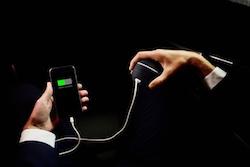Extending the life of smartphone batteries is the puzzle that all tech giants are trying to solve. But amateurs can also provide alternative solutions. This is what Michael Vaga did with his “HandEnergy” charger.
The 19-year-old inventor invented and developed a battery that uses energy from the human body to recharge. All you have to do is hold it in your hand - easy, it's shaped like a tennis ball - and make rotational movements with your wrist.
To work, the invention is based on the movements of a gyroscope, a device present in the majority of smartphones which makes it possible to determine their orientation. “With each rotation of your hand, the speed of the rotor [central platter of the gyroscope, Ed] increases significantly and generates more power. The average speed of the rotor is 5,000 rpm, ”explains the inventor, who lives in Minsk in Belarus, in the Telegraph.
“We transform mechanical energy into electrical energy, which allows you to charge your device. » It takes between 40 minutes and an hour to fully charge the battery. And if a smartphone is plugged in while charging, it takes 30% longer.
" Clean energy "

Given the constraint that it represents to make wrist movements for an hour, this device should be reserved for emergency situations, where no other means of recharging is available. But its advantage, underlines its inventor, is to be very easy to transport and to generate “clean energy”.
Michael Vaga took about a year to develop his device, before raising funds on the crowdfunding site Kickstarter. More than 70,000 euros in donations were made by online contributors, 20,000 euros more than he was looking to raise. HandEnergy should be available from March 2017, for 99 euros.
Insole-battery, exoskeleton-battery...
Why didn't we think of it before? In fact, many other inventors have already attempted to harness the energy generated by the body. Among the devices designed recently, we can mention the sole of SolePower . This insole uses the energy produced by the pressure of the foot when walking and can recharge a smartphone in three kilometers of walking.
Angelo Casimiro, 15, had somewhat the same idea in 2014 by developing soles with piezoelectric membranes. But if the concept was found, the technique was still in its infancy: the young inventor, who participated in the Google Science Fair, estimated that it took about eight hours of jogging to recharge 20% of the battery of a smartphone.
Another innovation that dates back to 2012: an “energy harvester” placed at knee level. Developed by engineers from the universities of Cranfield, Liverpool and Salford, and funded by the British Ministry of Defence, this device transforms the energy produced by the knee joint into electricity.
The American army is going to test a device of the same kind, the PowerWalk Kinetic Energy Harvester, from the company Bionic Power Inc. US Army in New Atlas. “A portable energy harvesting device would reduce the weight on its back, but also minimize the unit's dependence on supplies. In the form of a lightweight exoskeleton, it is worn over the uniform, also at knee level, and can charge up to four smartphones in an hour.
Medical deserts, public services: what assessment of Macron on rurality?
The best phones in 2021 for photos and video
What is the best Oppo smartphone to choose?
Good Plan: the recap of 4G packages on sale